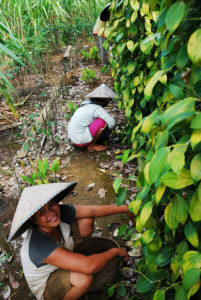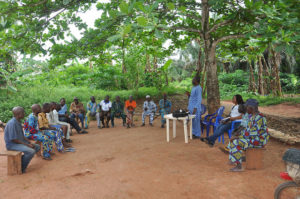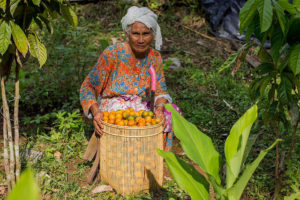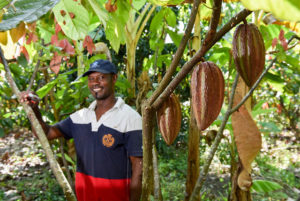
By Fergus Sinclair, Leader Agroforestry Systems, World Agroforestry Centre and Coordinator Flagship 2
The livelihood systems flagship of FTA has set out a bold research agenda from 2017 to 2022 to enhance how trees and forests contribute to smallholder livelihoods, particularly by improving food and nutrition security and increasing household income in the face of global change.
Not everyone agrees that trees can make a difference, and much of the agricultural establishment still sees an antipathy between farming and forestry, but we have more and more evidence that, if managed appropriately, trees can sustain and increase agricultural productivity for many smallholders in developing countries, and address the simultaneous need for food, energy and water in a sustainable way.
It is time to change outdated perspectives: trees and forests should take their rightful place in meeting the United Nations Sustainable Development Goals.
A Systems Approach
In a recent independent evaluation of the Trees for food security project funded by ACIAR (the Australian Centre for International Agricultural Research), farmers in Ethiopia articulated the need for a systems approach to agricultural improvement far more eloquently than researchers have ever done.

They were appreciative of the trees established on their farms through the project, but they pointed out that they also needed better water management to realize the potential of the trees (as well as for domestic use and crop irrigation) and to control livestock grazing, if the trees were not to be eaten in the dry season, when herds of camels moved across their landscape. This points to a key problem with much agricultural research.
Often researchers are focused on one component of a farming system: the trees, the maize or the livestock and assume that, as in industrial agricultural systems of the North, maximizing the yield of one component is the key objective.
This is not what smallholders want. They need to maximize the total factor productivity of their whole livelihood system, and this includes more than just agriculture, they may be involved in processing and marketing their farm produce, utilization of forests, or opportunities to earn off-farm income.
Better management of trees can be central to sustainable intensification of smallholder farms through managing interactions–for example producing fuelwood and fodder on the farm from trees, means that people–usually women–don’t have to spend time collecting them and can devote that time to other productive endeavors.

But, agroforestry is not yet considered in global assessments of research impact, because the crop production models that drive them can’t accommodate interactions between trees and crops. Our flagship will be changing this in 2017 through a strategic collaboration with the Australian Commonwealth Scientific and Industrial Research Organisation (CSIRO) to develop globally calibrated crop models that incorporate trees.
Flagship 2 is also breaking new ground by using systematic planned comparisons embedded in development initiatives to accelerate development impact. Through key investments from ACIAR, the United Nations International Fund for Agricultural Development (IFAD) and the European Union, and the UK Department for International Development (DFID), thousands of farmers across five countries in Africa will be involved in trying out different options for using trees to improve food and nutritional security, and restore degraded land.
Read also: “Influence flows both ways”: Partnerships are key to research on Livelihood systems
Already this year, the only maize that some farmers in Kenya will harvest is coming from what they planted in trial water harvesting basins, but the power of the planned comparison approach is that it not only delivers locally adapted options today, but also international public goods in terms of understanding how contextual factors condition suitability of options that will enable scaling out.
The food, water, energy nexus
Building on the need for adopting a systems approach, Flagship 2 has a research cluster that focuses on smallholders’ production of timber, food, fuel and non- timber forest products and their marketing.
This connects to research on trees in support of sustainable intensification which looks at how trees impact water cycling on fields and farms and to research under Flagship 4 addressing how trees and forests impact water cycling at landscape and continental scales.
There is a strong focus on value chains that has attracted investment principally from ACIAR and IFAD to develop novel market-based agroforestry options in Uganda, Zambia, Indonesia and Vietnam, and new approaches to managing the forest-farm interface in Burkina Faso and Ghana.

Tree crop commodities
Some of the most valuable globally traded commodities coffee, cocoa, oil palm and rubber are derived from tree crops, and the majority of production comes from smallholders rather than from large plantations. However, plantations are often the more familiar images that people have in their minds.
Cote d’Ivoire produces around 40% of the global supply of cocoa mainly from smallholder farms, many run by migrant people from drier countries to the north. The cocoa production is now threatened by aging cocoa farms that need rejuvenation (including re-stocking and appropriate fertilization) and by the spread of the virulent cocoa swollen shoot virus disease (CSSVD) that destroys cocoa plants.
Funded by a public private partnership with Mars, we are at the forefront of arresting the spread of CSSVD in Cote d’Ivoire and developing strategies how to rejuvenate and fertilize the crops.
In 2017, this research cluster will also work with Natura on USAID-funded research on oil palm diversification in Brazil and with a range of partners on cocoa and coffee production systems at the forest margin in Peru.
Read also: “Scientists without borders”: ICRAF’s Director General on CGIAR Research Program on Forests, Trees Agroforestry
Trees in support of sustainable intensification
The largest investment in our portfolio goes to research on how trees underpin soil health and can intensify system interactions on smallholder farms to improve farm income and food and nutrition security.
This research builds on research from FTA Phase 1 that established how trees in fields support greater abundances and activity of beneficial soil organisms as well as tighter water and nutrient cycling.
Fertilizer trees have been shown to be a low-cost way to increase crop yields across Africa, but the performance of different options varies greatly with soil, climate, topographical position, altitude, farm system, household endowments, market access, social capital and the prevailing policy and institutional context within which farmers operate.
For the first time, Flagship 2 will measure the performance of tree-intensification and restoration options with thousands of farmers, across thousands of hectares in five countries in sub-Saharan Africa, using systematic planned comparisons coupled with recent advances in information technology to capture monitoring data from large sample sizes with simple data recording formats with smart phones apps.
This will generate unique data from which a much deeper understanding of the factors that control performance of different agroforestry options (tree species and management practices) can be derived.
Silvopastoral systems
2017 sees the dawn of a new research cluster within our Flagship on silvopastoral systems. It will be co-ordinated by CATIE in Costa Rica but involves research globally, including on the effect of pruning fodder trees in the Sahel, dairy development in East Africa and the value of bamboo as a fodder resource.
In addition to being a strategic fodder resource, trees on pastures have huge potential to reduce stress on livestock that accounts for huge production losses and for animal welfare concerns.
We will work with FTA Flagship 5 on the key role that trees on pastures can play in climate mitigation and adaption strategies for cattle production systems and hence with FTA Flagship 3 how they can underpin sustainable beef certification.











